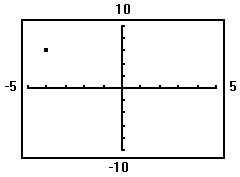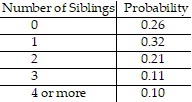Determine the coordinates of the points shown. Tell in which quadrant the point lies. Assume the coordinates are integers.
A. (-4, 3); quadrant I
B. (-4, 3); quadrant II
C. (-4, 6); quadrant I
D. (-4, 6); quadrant II
Answer: D
You might also like to view...
Find the difference.-  -
- 
A. 
B. - 
C. - 1
D. - 
Solve the system.x2 + 2xy + y2 = 9x2 + 2xy - y2 = -9
A. {(0, 3), (0, -3), (6, 3), (6, -3)} B. {(0, 3), (0, -3), (6, 3), (-6, -3)} C. {(0, 3), (0, -3), (-6, 3), (-6, -3)} D. {(0, 3), (0, -3), (-6, 3), (6, -3)}
Use these sets to find the following. Identify any disjoint sets.Let U = {8, 9, 10, 11, 12, 13, 14, 15, 16, 17, 18}, M = {8, 10, 12, 14}, 
 and
and  ? ? N
? ? N
A. {8, 9, 10, 11, 12, 13, 14, 15, 16, 17, 18} B. N, or {9, 11, 13, 15, 17}; N and ? are disjoint sets. C. ?; N and ? are disjoint sets. D. {10, 12, 14, 16, 18}
Solve the problem.In a survey about the number of siblings of college students, the following probability table was constructed:  What is the probability that a student has at least 2 siblings?
What is the probability that a student has at least 2 siblings?
A. 0.79 B. 0.42 C. 0.58 D. 0.21